The Golden Age of Flight:
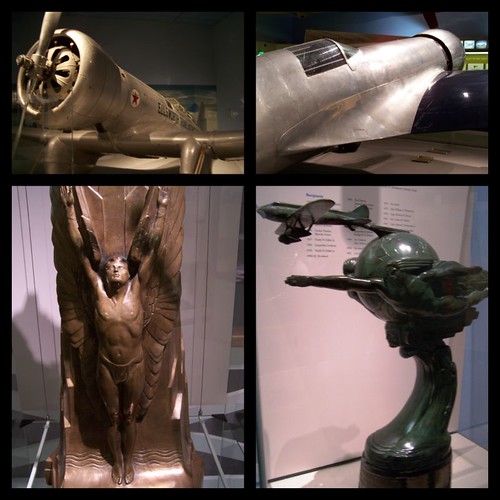
A Northrup Gamma Polar Star which made many Arctic runs. In fact, there were two penguins standing nearby!
A Hughes H-1 racer (yes, Howard Hughes) in which he broke the airspeed record in 1937 at 352 mph / 567 kmph.
Two beautiful art deco racing trophies. What a gorgeous thing to win.


A lovely 1936 Beech Staggerwing, built as a cutting edge, comfortable business plane during the Great Depression. This model belonged to Buzz Aldrin's father, who was an executive for Standard Oil Development Co in NYC. In its lifetime it was owned by other oil companies, charter and sightseeing companies, and even performed coastal patrol duty during WWII, and was finally retired to the museum in 1980.
Military UAVs (Unmanned Aerial Vehicles):
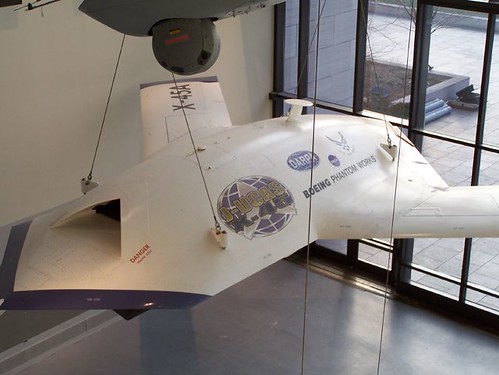
The Boeing X-45 Phantom - look at that, it was developed by DARPA, NASA, and the USAF. (DARPA is really cool, they are funding the intriguing BigDog project...)
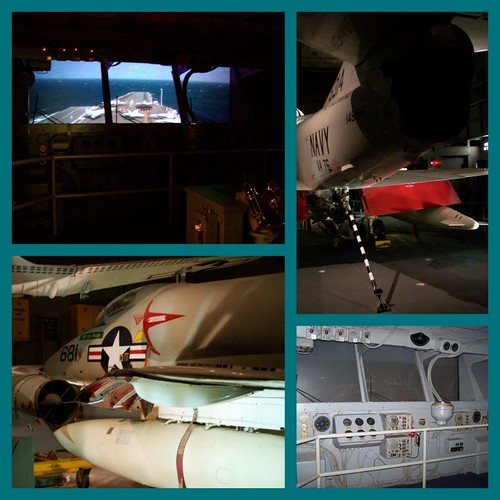
On the bridge of the USS Smithsonian which is basically a hall mocked up like an aircraft carrier, complete with footage of the flight deck.

Supermarine Spitfire
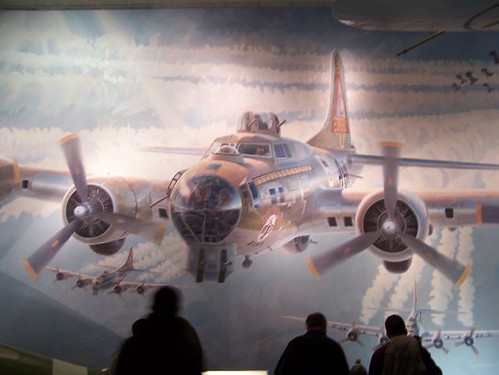
Mural of a Flying Fortress
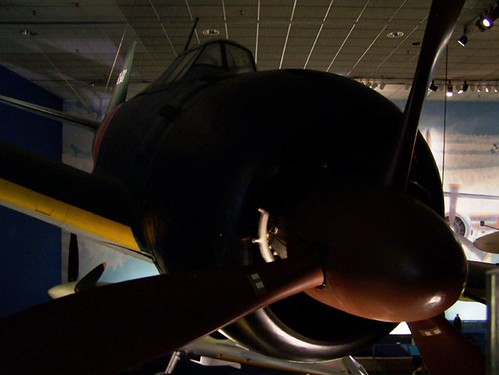
A fearsome (from this angle) Mitsubishi A6M5 Zero of the type used in the Pearl Harbor attack. Kamikaze anyone?

An Italian Macchi Volgore (hahaha! at first I'd typed Vongole).
If I'd noticed the sweet little P-51 Mustang underneath it, I'd have tried for a proper photo of that too, but I was here on a FLYING VISIT! Ah, sometimes I crack myself up.
Here is a little WWII Tidbit you might like.
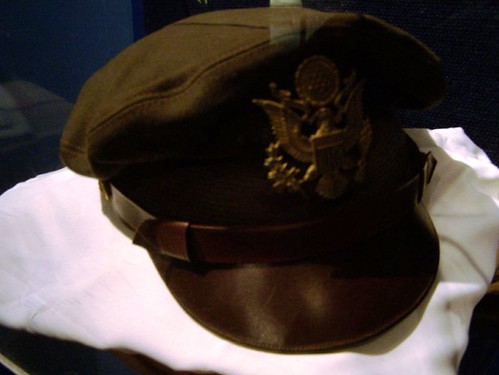
The new flight cap had the hard inner lining removed for easy packing into a flight bag. The more crumpled it was, the more flight time the wearer was assumed to have accumulated. Imagine the young swanks beating up their caps to attain that look.
Also, see the white scarf folded underneath the cap? It is a classic image but with a practical reason: made of a length of parachute silk, it was partly for warmth but mostly to prevent chafing of the pilot's neck for all the repetitive movement and head-turning he was required to perform inside the cockpit.
And speaking of silk, I saw inside another case one of those famed silk/rayon escape maps easily concealed on the person to be used to evade capture in case of being dropped, crashing, or landing behind enemy lines...
Military UAVs (Unmanned Aerial Vehicles):

The Boeing X-45 Phantom - look at that, it was developed by DARPA, NASA, and the USAF. (DARPA is really cool, they are funding the intriguing BigDog project...)
So, UFOs are real. Next time, I will take a photo of the DarkStar, now if I remember correctly, that one may have been responsible for a number of sightings in the desert Southwest back in the 90s.

I find this picture more pleasing. The General Atomics Predator. Isn't it amazing that these things are controlled from the ground with a joystick, video-game-style?

I find this picture more pleasing. The General Atomics Predator. Isn't it amazing that these things are controlled from the ground with a joystick, video-game-style?
Sea-Air Operations:

On the bridge of the USS Smithsonian which is basically a hall mocked up like an aircraft carrier, complete with footage of the flight deck.
And here is a Douglas A-4C Skyhawk (1959) forward fuselage, and tailhook. This plane served in Vietnam in 1967 and was retired to the museum in 1975.
WWII Aviation:

Supermarine Spitfire

Mural of a Flying Fortress

A fearsome (from this angle) Mitsubishi A6M5 Zero of the type used in the Pearl Harbor attack. Kamikaze anyone?

An Italian Macchi Volgore (hahaha! at first I'd typed Vongole).
If I'd noticed the sweet little P-51 Mustang underneath it, I'd have tried for a proper photo of that too, but I was here on a FLYING VISIT! Ah, sometimes I crack myself up.
Here is a little WWII Tidbit you might like.

The new flight cap had the hard inner lining removed for easy packing into a flight bag. The more crumpled it was, the more flight time the wearer was assumed to have accumulated. Imagine the young swanks beating up their caps to attain that look.
Also, see the white scarf folded underneath the cap? It is a classic image but with a practical reason: made of a length of parachute silk, it was partly for warmth but mostly to prevent chafing of the pilot's neck for all the repetitive movement and head-turning he was required to perform inside the cockpit.
And speaking of silk, I saw inside another case one of those famed silk/rayon escape maps easily concealed on the person to be used to evade capture in case of being dropped, crashing, or landing behind enemy lines...
10 comments:
Wonderful tour, Liv. I thought that mural was smashing. And how cool that they set it up so you can feel what it must have been like to be behind the cockpits of these flying machines. Those UAVs are kind eerie looking - not quite real, if you know what I mean.
Excellent stuff! Glad (like many Brits I suppose) that you included a piccie of the spitfire! Greetings from Blighty!!!
Lovin' it!!!!
More!!! More!!!!
I'm amazed they have a Zero there, and I wonder if it's authentic. Examples that survived the war are extremely rare even (especially?) in Japan, partly because they were built cheaply on purpose (to save on metals, which were in short supply in Japan) and partly because the U.S. occupation destroyed pretty much any surviving Japanese military aircraft they could get their hands on.
Even the "Zeros" flown by the Confederate Air Force, which have been used in movies, were actually American T-6 trainers modified to look like Zeros. In Japan the only surviving authentic Zero I'm aware of is the one they keep at Yasukuni Shrine, the one dedicated to Japan's war dead (and a hotbed of extreme right-wing beliefs that continue to be a thorn in the sides of Korea and China).
Nikki - it was even more fun clambering around on the "aircraft carrier". The cockpits were behind plexiglass.
********************
Mark - there were two pics of the Spitfire, the other is on my Flickr page>
This model, I forgot to say, was flown in the USAF.
*******************
Minstrel - the museum is of course aware of the rarity of this plane.
This is their note on the Zero:
We believe the A6M5 Zero Model 52 on display in the National Air and Space Museum came from a group of Japanese aircraft captured on Saipan Island in April 1944. Navy personnel removed 12 late-model Zeros from the island and sent them to the United States for evaluation. The earliest records pertaining to the Museum's Zero show that it was evaluated in 1944 at Wright Field, Ohio, and the following year at Eglin Field, Florida.
ooh, show us more. I would also like to see more of DC. Maybe me and chad should come visit u soon
Liv, thanks for setting this post out so interestingly! It would be perfect in a brochure advertising the place! I find museums fascinating ~ so much history right at hand, and especially in one such as this! I think a person could spend a good portion of their lifetime in such places and still have much more to see and learn. Wonderful photos and I appreciate the details that accompany them. Looking forward to more. I bet you are getting excited about your move that's coming up!
Mich - ha! The same comment 3 times, is that good luck or something? I deleted the other two.
Hey, everyone is suddenly interested in coming to see me when I move down. I like this!
*************
Glo - ooh! Thank you :-D
I went through the place so fast I wasn't even able to absorb all the info that I wanted. These installments are but the tip of the iceberg.
I AM SO excited about the move, yes indeedy. But ohhhhhh my goodness, I have been fielding quotes from movers all morning and the numbers are scary, even the lower ones :-o
Liv, that is a great post, thanks for showing all those pictures! It looks like a *really* amazing museum.
I especially like the cap anecdote :)
x
Thanks for the continuing tour of the NASM! As one of the world's great aerospace museums it has, not surprising, plenty of fabulous exhibits as you've shown here. xx
Pete - FYI, but I haven't been able to access your blog in months, is it down???
x
*********************
Flighty - thousands!
xx
Post a Comment